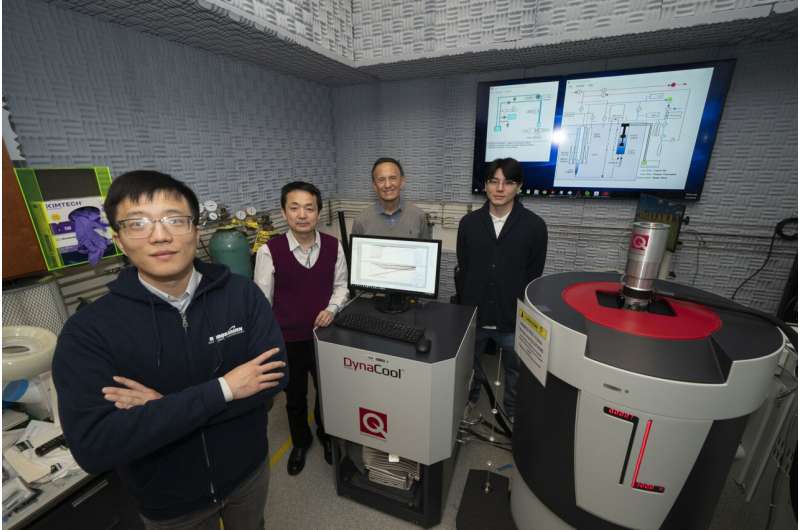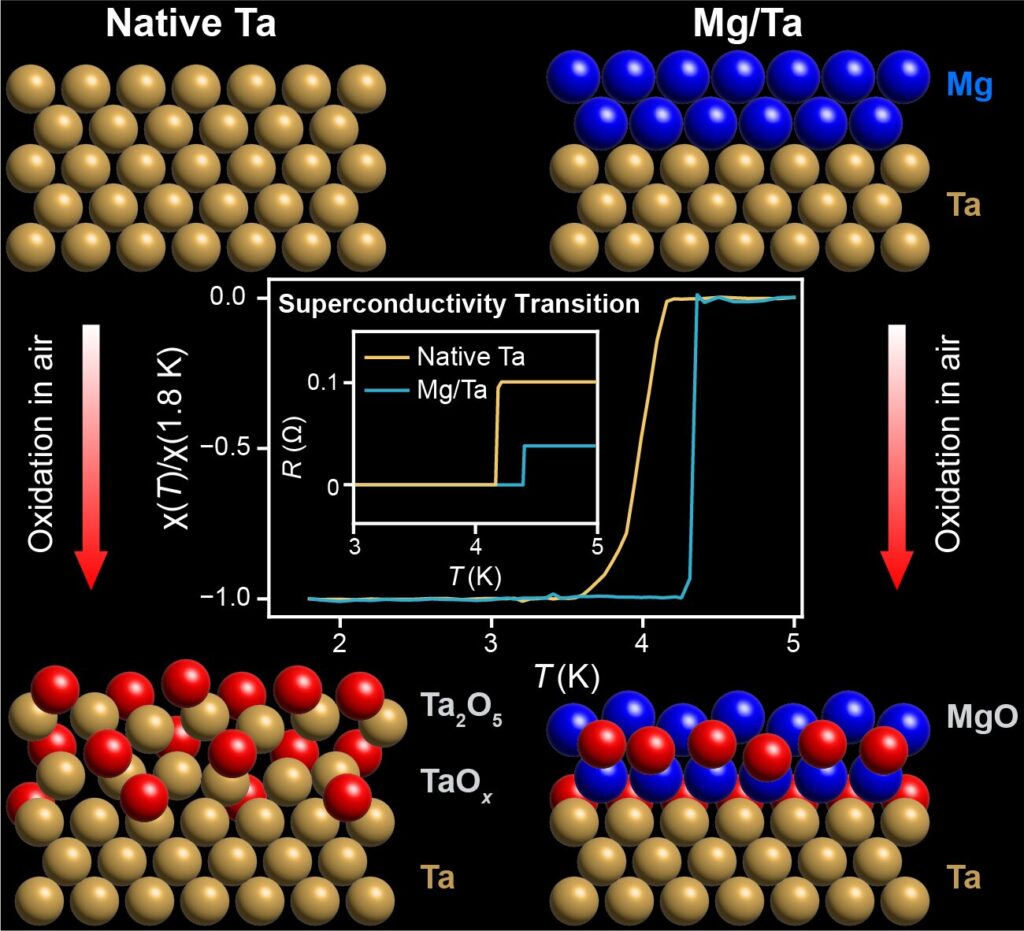Scientists at the U.S. Department of Energy’s (DOE) Brookhaven National Laboratory have discovered that adding a layer of magnesium improves the properties of tantalum, a superconducting material that shows great promise for building qubits, the basis of quantum computers.
As described in a paper published in the journal Advanced Materials, a thin layer of magnesium keeps tantalum from oxidizing, improves its purity, and raises the temperature at which it operates as a superconductor. All three may increase tantalum’s ability to hold onto quantum information in qubits.
This work builds on earlier studies in which a team from Brookhaven’s Center for Functional Nanomaterials (CFN), Brookhaven’s National Synchrotron Light Source II (NSLS-II), and Princeton University sought to understand the tantalizing characteristics of tantalum, and then worked with scientists in Brookhaven’s Condensed Matter Physics & Materials Science (CMPMS) Department and theorists at DOE’s Pacific Northwest National Laboratory (PNNL) to reveal details about how the material oxidizes.
Those studies showed why oxidation is an issue.
“When oxygen reacts with tantalum, it forms an amorphous insulating layer that saps tiny bits of energy from the current moving through the tantalum lattice. That energy loss disrupts quantum coherence—the material’s ability to hold onto quantum information in a coherent state,” explained CFN scientist Mingzhao Liu, a lead author on the earlier studies and the new work.
While the oxidation of tantalum is usually self-limiting—a key reason for its relatively long coherence time—the team wanted to explore strategies to further restrain oxidation to see if they could improve the material’s performance.
“The reason tantalum oxidizes is that you have to handle it in air and the oxygen in air will react with the surface,” Liu explained. “So, as chemists, can we do something to stop that process? One strategy is to find something to cover it up.”

All this work is being carried out as part of the Co-design Center for Quantum Advantage (C2QA), a Brookhaven-led national quantum information science research center. While ongoing studies explore different kinds of cover materials, the new paper describes a promising first approach: coating the tantalum with a thin layer of magnesium.
“When you make a tantalum film, it is always in a high-vacuum chamber, so there is not much oxygen to speak of,” said Liu. “The problem always happens when you take it out. So, we thought, without breaking the vacuum, after we put the tantalum layer down, maybe we can put another layer, like magnesium, on top to block the surface from interacting with the air.”
Studies using transmission electron microscopy to image structural and chemical properties of the material, atomic layer by atomic layer, showed that the strategy to coat tantalum with magnesium was remarkably successful. The magnesium formed a thin layer of magnesium oxide on the tantalum surface that appears to keep oxygen from getting through.
“Electron microscopy techniques developed at Brookhaven Lab enabled direct visualization not only of the chemical distribution and atomic arrangement within the thin magnesium coating layer and the tantalum film but also of the changes of their oxidation states,” said Yimei Zhu, a study co-author from CMPMS. “This information is extremely valuable in comprehending the material’s electronic behavior,” he noted.
X-ray photoelectron spectroscopy studies at NSLS-II revealed the impact of the magnesium coating on limiting the formation of tantalum oxide. The measurements indicated that an extremely thin layer of tantalum oxide—less than one nanometer thick—remains confined directly beneath the magnesium/tantalum interface without disrupting the rest of the tantalum lattice.
“This is in stark contrast to uncoated tantalum, where the tantalum oxide layer can be more than three nanometers thick—and significantly more disruptive to the electronic properties of tantalum,” said study co-author Andrew Walter, a lead beamline scientist in the Soft X-ray Scattering & Spectroscopy program at NSLS-II.
Collaborators at PNNL then used computational modeling at the atomic scale to identify the most likely arrangements and interactions of the atoms based on their binding energies and other characteristics. These simulations helped the team develop a mechanistic understanding of why magnesium works so well.
At the simplest level, the calculations revealed that magnesium has a higher affinity for oxygen than tantalum does.
“While oxygen has a high affinity to tantalum, it is ‘happier’ to stay with the magnesium than with the tantalum,” said Peter Sushko, one of the PNNL theorists. “So, the magnesium reacts with oxygen to form a protective magnesium oxide layer. You don’t even need that much magnesium to do the job. Just two nanometers of thickness of magnesium almost completely blocks the oxidation of tantalum.”
The scientists also demonstrated that the protection lasts a long time: “Even after one month, the tantalum is still in pretty good shape. Magnesium is a really good oxygen barrier,” Liu concluded.
The magnesium had an unexpected beneficial effect: It “sponged out” inadvertent impurities in the tantalum and, as a result, raised the temperature at which it operates as a superconductor.
“Even though we are making these materials in a vacuum, there is always some residual gas—oxygen, nitrogen, water vapor, hydrogen. And tantalum is very good at sucking up these impurities,” Liu explained. “No matter how careful you are, you will always have these impurities in your tantalum.”
But when the scientists added the magnesium coating, they discovered that its strong affinity for the impurities pulled them out. The resulting purer tantalum had a higher superconducting transition temperature.
That could be very important for applications because most superconductors must be kept very cold to operate. In these ultracold conditions, most of the conducting electrons pair up and move through the material with no resistance.
“Even a slight elevation in the transition temperature could reduce the number of remaining, unpaired electrons,” Liu said, potentially making the material a better superconductor and increasing its quantum coherence time.
“There will have to be follow-up studies to see if this material improves qubit performance,” Liu said. “But this work provides valuable insights and new materials design principles that could help pave the way to the realization of large-scale, high-performance quantum computing systems.”


